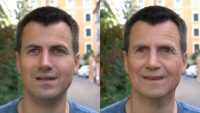Disney Invents High-Quality Tool to Rejuvenate or Age Actors
December 13, 2022
Disney Research Studios has created an AI tool that can make actors look older or younger more simply than the costly and time-consuming visual effects that are the current status quo. While artificial intelligence had been used to age or de-age people with relative success in still frames, the results lacked photorealism when applied to video. Disney calls its app FRAN, for Face Re-Aging Network. FRAN has been trained to identify the parts of a face that change with age and can either accentuate or erase the telltale signs.
While FRAN advances the popular 2D approach to age-altering, Disney says there are some use cases that may require a traditional 3D VFX workflow. But a cost-benefit analysis might find FRAN a fitting solution, depending on the complexity of the work.

“It’s said to take the AI just five seconds to apply the aging effects to a single frame,” Engadget reports, noting artists can still “fine tune the effect of aging with more localized control and creative freedom thanks to the AI,” layering over FRAN’s work.
Suggesting “as much as $200 million” of the budget for “The Irishman” “went toward making Robert De Niro, Al Pacino and Joe Pesci look younger,” Engadget thinks FRAN may be a cost-efficient option.
In a paper published for SIGGRAPH Asia, Disney researchers explain how their new invention started with datasets of thousands of machine-generated synthetic faces that were aged, then rejuvenated — essentially creating a facial timeline — using existing AI aging tools.
Those re-aged images were then fed into a new database that was used to train FRAN using a convolutional neural network approach known as U-Net that Disney researchers adapted from from the medical field. As with the approach known as few-shot, U-Net is said to produce accurate images with lesser input.
For input, FRAN uses “a 5-channel tensor comprising the RGB image to be re-aged and two single-channel age maps that specify the input and output age for each image pixel,” Disney explains, adding “the U-Net then predicts per-pixel RGB deltas (offsets) that are added on top of the input image to create the final re-aged result.”
Leveraging synthetic data to “formulate facial re-aging as a practical image-to-image translation task” could be achieved “by training a well-understood U-Net architecture, without the need for more complex network designs.” FRAN produces results that “advance the state of the art for re-aging real faces on video with unprecedented temporal stability and preservation of facial identity across variable expressions, viewpoints, and lighting conditions,” the team says.
Gizmodo says that “two years ago, Disney Research Studios developed AI-powered tools that could generate face swap videos with enough quality and resolution to be used for professional filmmaking,” with the goal of creating “an age-altering AI tool that was ready for the demands of Hollywood and flexible enough to work on moving footage or shots where an actor isn’t always looking directly at the camera.”

No Comments Yet
You can be the first to comment!
Sorry, comments for this entry are closed at this time.